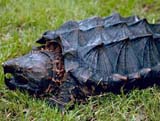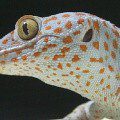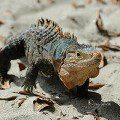
iguana black
Regarding black iguanas, there is very conflicting information on the Internet. Some sources indicate that the genus of black iguanas Ctenosaura is represented by a single species of Ctenosaura pectinata. Others say that there is no such genus at all, but there is a genus of spiny-tailed iguanas and several species of lizards belong to it, among which there are black individuals. If we compare information from the network and scientific literature, then the following conclusion suggests itself: of course, the genus Ctenosaura exists. It just has two names – spiny-tailed and black iguanas – because of which confusion arose, since there are carriers of both traits in the genus. This article will focus on black iguanas. Indeed, there are several species of these lizards: the already mentioned species of Wigman’s black iguana Ctenosaura pectinata, the most typical species of the spiny-tailed black iguana Ctenosaura similis, the species of Mexican black iguanas Ctenosauria acanthura and the smallest representatives of the genus of black lizards Ctenosaura clarki. All black iguanas are found in North and South America, and almost all of them are objects of hunting for humans, since the meat and eggs of these lizards are very tasty. In terms of terrarium keeping, black iguanas are not the best pets, they are difficult to tame. But some species are still quite popular in the collections of exotic reptile lovers.
Contents
Classification
Kingdom: Animals
Type: Chordates Class: Reptiles Order: Scaly Suborder: Lizards Family: Iguanas Genus: Black iguanas
Appearance
 All of the aforementioned types of black iguanas have their own characteristics, so it is worth considering them separately.
All of the aforementioned types of black iguanas have their own characteristics, so it is worth considering them separately.
Ctenosaura similis is one of the largest members of the genus, adult males can grow over a meter. Interestingly, juvenile Ctenosaura similis iguanas acquire black coloration only with age, and initially wear a greenish camouflage outfit. However, adult black iguanas of this species can be colored close to the conditions in which they live. Their most common body color is gray with black stripes. But sometimes there are silver-gray or even bluish reptiles, and some lizards Ctenosaura similis have orange or reddish blotches in color. Moreover, during the breeding season, bright spots in males become the most noticeable or appear if they were not observed before. Also, the males of this black iguana have a pronounced dorsal crest. And, of course, all individuals have a fairly long and spiny tail.
Black iguanas Ctenosaura pectinata are not as large, but their dorsal crest is more pronounced. Their coloration is rather gray-brown, and the abdomen has a lighter yellowish tint. And of course, the tail of the black iguana Ctenosaura pectinata is just as spiked.
Ctenosaura acanthura lizards are also capable of growing to over a meter in length. Their coloration is quite variegated. The base color of the body is black with a white or cream pattern of spots and stripes.
The smallest black iguana Ctenosaura clarki measures about 30 cm.
All types of black iguanas are quite unusual in terms of appearance. They have elongated muzzles, various folds on the body, rough scales and long tails, which, thanks to their spikes, can become a reliable weapon for protecting and defending the life of a lizard. A rather variegated coloration with a predominance of dark tones and a high dorsal crest “a la Mohawk” makes these lizards especially look like fantastic creatures. And some individuals have a “third eye” – a light-sensitive bulge on the crown. Scientists have discovered that a real pupil is located in it, only a very small one, with the help of which the iguana, although it does not distinguish colors, can quite notice the flickering shadow of a predator. And with the help of this parietal eye, heat-loving black iguanas determine whether they received enough sunlight by basking in the sun. And if the internal “dosimeter” shows that enough is enough, the lizard immediately moves into the shade or hides in a shelter.
Distribution and habitation
The most common black iguanas in Central America, in particular, on the Pacific coast. Although they prefer dry areas, they usually hide where there is some kind of vegetation – trees, shrubs – under the roots of which it is easy to find shelter. By the way, meeting a black iguana on the beach is a common thing. As for specific species, then, of course, each of them has its own habitat.
Ctenosauria acanthura, for example, is found in Mexico. This black iguana is a resident of rocks and ruins. People often encountered it on the territory of the excavations of the ancient settlements of the Mayan Indians, in various destroyed structures, and near the Atlantic coast, this lizard prefers to hide in crevices of stones and bask on rocky ledges.
The spiny-tailed black iguana Ctenosaura similis can be found from Mexico to Panama, in particular, in the southern Mexican territories and in such states as Nicaragua, Guatemala, El Salvador, Honduras, Belize, Costa Rica. The lizard also spread to the nearest islands. She, unlike the species described above, prefers forest and shrub zones and can live both on the ground and in trees.
The black iguana Ctenosaura pectinata also lives in Mexico, but in the western part of the country. And from there it was introduced to the south of the United States, to states such as Texas and Florida. This lizard is an excellent climber. Its characteristic biotopes are rocky terrain or tree thickets, in general, places where you can actively climb. Sometimes this black iguana can also be encountered in settlements, near residential buildings or other artificial structures.
And almost there, in the west of Mexico, there are the smallest black iguanas Ctenosaura clarki. True, the number of this species, alas, is gradually declining due to the decrease in the natural habitats of lizards under human influence.
Behavior and lifestyle
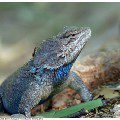 Researchers have repeatedly noted such a feature of black lizards as thermophilicity. This is facilitated by their dark color, which absorbs heat better. And black iguanas, in this case, are no exception. For most of the day when they are active, these reptiles prefer to bask on rocks, with the males in the iguana group usually occupying the highest positions. But most black iguanas are territorial and prefer to be alone. The exception is Ctenosaura pectinata. In other species of iguanas, only harems are possible, when there are several, up to 10, females next to one male. In general, black iguanas are not aggressive animals, they can let a person close enough to them and then slowly leave. Only female lizards are especially shy and hide only when they see danger.
Researchers have repeatedly noted such a feature of black lizards as thermophilicity. This is facilitated by their dark color, which absorbs heat better. And black iguanas, in this case, are no exception. For most of the day when they are active, these reptiles prefer to bask on rocks, with the males in the iguana group usually occupying the highest positions. But most black iguanas are territorial and prefer to be alone. The exception is Ctenosaura pectinata. In other species of iguanas, only harems are possible, when there are several, up to 10, females next to one male. In general, black iguanas are not aggressive animals, they can let a person close enough to them and then slowly leave. Only female lizards are especially shy and hide only when they see danger.
Among the black iguanas, there is also a speed record holder – Ctenosaura similis. This lizard is the fastest not only in its kind, but among all reptiles in general. She is able to move at a speed of 34 km / h. Although, in general, all black iguanas are quite mobile creatures. True, they do not go far from their habitats, preferring to look for food nearby, so that in case of danger they can hide in a hole, crevice or climb higher to the nearest tree.
Male lizards periodically tend to go around their possessions, examining them for someone else’s invasion. And if such an invasion happened, it is dangerous for the lizard, and there is nowhere to run, then the black iguana will actively defend itself, whipping the enemy with its prickly tail.
Among male black iguanas, there are fights for females, and sometimes for a whole harem. Moreover, females accept any winner, even if it is a new lizard that has come to their site. For this reason, it is not recommended to keep several males in a group of iguanas in terrariums, it is better to have one male and several females. Although in general, black iguanas are the least aggressive species of reptiles. The owners of nurseries noted that these creatures, although not too easy to tame, soon begin to “respond” in one way or another to various actions of people. For example, black iguanas can “pose” when they are photographed, that is, freeze in immobility in front of a flash. The main thing is not to deprive these creatures of the sun that is vital for them, because ultraviolet radiation affects the strengthening of the bones of lizards. In a terrarium, it can be replaced with an appropriate lamp.
Food
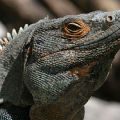 Black iguanas transition to a vegetarian diet as they mature. But young individuals eat insects, crayfish, small animals, birds and bird eggs. Over time, various fruits, leaves and shoots of available plants begin to predominate in the diet of lizards. In a terrarium, it is also recommended to feed young black iguanas with insects, gradually increasing the percentage of plant foods so that subsequently animal foods make up only 5% of the diet. Among animal food are insects such as crickets, flour beetles. In some nurseries, lizards are even given the meat of young rodents. And for a plant-based diet, lettuce, various fruits and flowers, for example, houseplants, are suitable. It is important that it be succulent vegetation, so that with its help the reptile receives not only nutrients, but also water. You can feed your black iguana a little each day, or you can schedule feedings 3-4 times a week. And be sure to mix vitamin and mineral supplements into the feed.
Black iguanas transition to a vegetarian diet as they mature. But young individuals eat insects, crayfish, small animals, birds and bird eggs. Over time, various fruits, leaves and shoots of available plants begin to predominate in the diet of lizards. In a terrarium, it is also recommended to feed young black iguanas with insects, gradually increasing the percentage of plant foods so that subsequently animal foods make up only 5% of the diet. Among animal food are insects such as crickets, flour beetles. In some nurseries, lizards are even given the meat of young rodents. And for a plant-based diet, lettuce, various fruits and flowers, for example, houseplants, are suitable. It is important that it be succulent vegetation, so that with its help the reptile receives not only nutrients, but also water. You can feed your black iguana a little each day, or you can schedule feedings 3-4 times a week. And be sure to mix vitamin and mineral supplements into the feed.
Reproduction
Mating of black iguanas occurs in late winter – early spring, most often in February. Some species have mating ceremonies. The met male and female, before proceeding to mating, actively nod their heads to each other, as if communicating in a sign language only they understand. But in most species, mating chases are still common, when the male catches the female, and from the side these catch-ups look quite aggressive. The male caught the girl roughly grabs by the neck and performs all the actions necessary for fertilization.
In all of the above species of black iguanas, something similar happens. They differ only in their fertility. The largest clutches are observed in the black iguana Ctenosaura pectinata. She has up to 50 eggs laid. The smaller Ctenosaura acanthura has 24 eggs, while the spiny-tailed iguana Ctenosaura similis has 30 eggs.
Females of all black iguanas prepare their own nesting site by digging a suitable hole in the sandy soil. The incubation period is also about the same – in black iguanas it is about 90 days. All babies are born green, but some species may be black-striped or flecked with brown. The young hatch and come out on their own, breaking the sand.
Sources of
http://ru.wikipedia.org
http://www.floranimal.ru/
http://www.apus.ru/
http://www.zooschool.ru
http://www.terraria.ru
http://en.wikipedia.org




